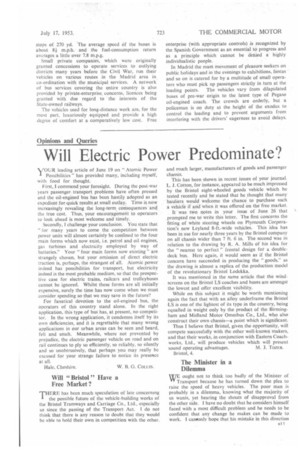Will Electric Power Predominate?
Page 47

If you've noticed an error in this article please click here to report it so we can fix it.
\f VOUR leading article of June 19 on "Atomic Power. OUR " has provided many, including myself, with food for thought.
First, I commend your foresight. During the post-war years passenger transport problems have often pressed and the oil-engined bus has been hastily adopted as an expedient for-quick results at small outlay. Time is now increasingly revealing the long-term consequences and the true cost. Thus, your encouragement to operators to look ahead is most welcome and timely.
Secondly, I challenge your conclusion. You state that "for many years to come the competition between power units will almost certainly be confined to the four main forms which now exist, i.e. petrol and oil engines, gas turbines and electricity employed by way of batteries." Your "four main forms now existing" are strangely chosen, but your omission of direct electric traction is, perhaps, the strangest of all. Atomic power indeed has possibilities for transport, but electricity indeed is the most probable medium, so that the prospective case for electric trains, railcars and trolleybuses cannot be ignored. Whilst these forms are all initially expensive, surely the time has now come when we must consider spending so that we may save in the future?
For fanatical devotion to the oil-engined bus, the operators of this country stand alone. In the right application, this type of bus has, at present, no competitor. In the wrong application, it condemns itself by its own deficiencies, and it is regrettable that many wrong applications in our urban areas can be seen and heard, felt and smelt. Meanwhile, where not prevented by prejudice, the electric passenger vehicle on road and on rail continues to ply so efficiently, so reliably, so silently and so unobtrusively, that perhaps you may really be excused for your strange failure to notice its presence at all.
Hale. Cheshire. W. B. G. Cows. and much larger, manufacturers of goods and passenger chassis.
This has been shown in recent issues of your journal. L. J. Cotton, for instance, appeared to be much impressed by the Bristol eight-wheeled goods vehicle which he tested recently and he stated that he thought that many hauliers would welcome the chance to purchase such a vehicle if and when it was offered on the free market.
It ' was two notes in your issue of June 26 that prompted me to write this letter. The first concerns the fitting of white steering wheels on Plymouth Corporation's new Leyland 8-ft.-wide vehicles. This idea has been in use for nearly three years by the Bristol company on all chassis wider than 7 ft. 6 in. The second was in relation to the drawing by R. A. Mills of his idea for the "nearest to perfect" frontal design for a doubledeck bus. Here again, it would seem as if the Bristol concern have succeeded in producing the "goods," as the drawing is almost a replica of the production model of the revolutionary Bristol L,odekka.
It was mentioned in the same article that the windscreens on the Bristol LS coaches and buses are amongst the lowest and offer excellent visibility.
While on this subject it might be worth mentioning again the fact that with an alloy underframe the Bristol ,LS is one of the lightest of its type in the country, being equalled in weight only by the product of the Birmingham and Midland Motor Omnibus Co., Ltd., who also construct their own chassis—a point which is significant.
Thus I believe that Bristol, given the opportunity, will compete successfully with the other well-known makers, and that their works, in conjunction with Eastern Coachworks, Ltd., will produce vehicles which will present sound operating advantages. M. 1. TOZER. Bristol, 4.




















































































